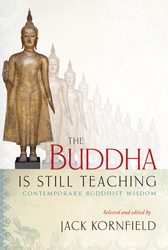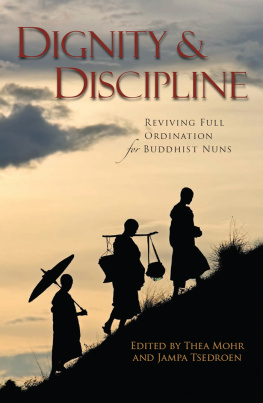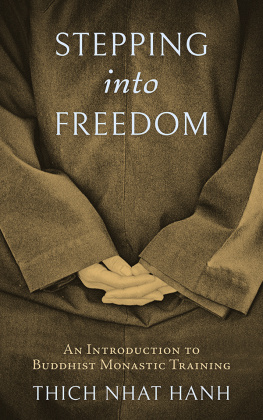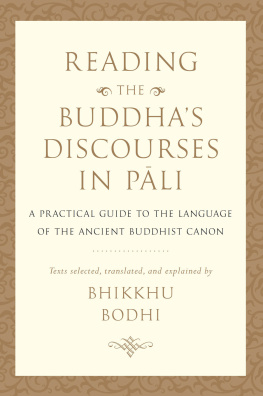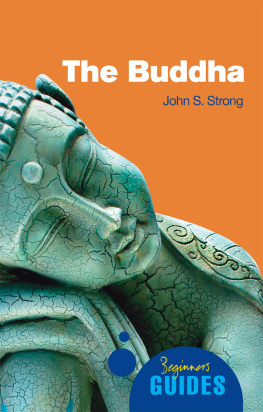Buddha Chapter, the First
Praise Him, the Blessed One, the Worthy One, the Fully Complete Buddha!
The Sage of Vedeha, his body bent, asked
the Thus-Gone-One dwelling in Jetavana,
Indeed there are those [called] Omniscient Buddhas;
through what causes do they become [so], Hero?
Then spoke the Omniscient, Outstanding, Great Sage,
to lucky nanda with [his] honeyed voice,
Who performed service among former Buddhas,
[but] didnt get freed in their dispensations, [2]
because that is the means to awaken, wise,
they with sharp knowing, through knowledge and power,
because of [their] wishes [and] also great strength,
do come to attain that state of omniscience. [3]
I too among former Buddhas
did wish to become a Buddha.
Through [my] mind alone there were
innumerable Dhamma-kings. [4]
[Now] listen, with purified minds,
to the legends of the Buddhas,
innumerable Dhamma-kings
who fulfilled thirty perfections. (1) [5]
I worshipped them [bowing] my head,
having praised with ten fingers pressed,
those World-Chiefs with followers [and]
the Best Buddhas Awakening. (2) [6]
I brought it all forth with my mind:
things on the ground and in the sky,
uncountable as are the gems
found in the fields of the Buddhas. (3) [7]
I created a palace there,
with a floor made out of silver.
Various floors made out of gems
arose and stretched up toward the sky. (4) [8]
There were varied well-made pillars,
well-proportioned, very costly.
The central beam was made of gold,
the gate was canopy-adorned. (5) [9]
The first floor, lapis lazuli,
was lovely as a stainless cloud.
Lotus ponds were scattered about
on a floor made of superb gold. (6) [10]
A coral [floor], coral-colored,
was red and [very] beautiful;
[that] floor lit up the directions
with light the hue of red beetles. (7) [11]
Doors and windows and turrets [too],
and four railings were well-laid-out.
It had a scented bamboo net
which was delightful to the mind. (8) [12]
There were excellent gabled roofs
[colored] blue [and] yellow [and] red,
white [and also] mixed black-and-white,
adorned with the seven gemstones. (9) [13]
Lovely [pictures of] birds and beasts
and lotuses fashioned for looks;
it was adorned with moon and sun,
dotted with star-constellations. (10) [14]
It was covered with a gold net
furnished with little golden bells.
Those gold garlands sang in the force
of the wind, delighting the mind. (11) [15]
A garland of flags was hoisted,
dyed of colors:
some light crimson, others deep red,
tawny, yellow and yellowish. (12) [16]
Numerous various hundreds
of slabs were made out of silver,
made of crystal, made of ruby,
[and] likewise made out of cats eye. (13) [17]
Various diverse couches were
spread with soft Benares muslin,
rugs, fine silk, and cloth from China,
fibrous cloth and yellow garments.
All of these various carpets
I laid out [on them] with my mind. (14) [17e-f, 18]
On this floor and that [floor] too,
ornamented with huts of gems,
effulgent torches [made of] gems
are being carried and fixed well. (15) [19]
Columns [and] pillars are splendid,
and beautiful golden gateways
made of special gold and hard woods,
and also made out of silver. (16) [20]
Varied windows, well-proportioned;
painted cross-bars [adorned] the doors,
with pots of plenty on both sides,
filled with lotuses and lilies. (17) [21]
I conjured up all past Buddhas,
World-Leaders, [their] Assemblies too,
with their natural complexions
[and] forms, and [all] their followers. (18) [22]
Having entered through the doorway
all the Buddhas and followers
sat down on chairs all made of gold
[and formed] an exalted circle. (19) [23]
Those Buddhas who live here-and-now,
who have no rivals in the world,
and those who lived in former times:
I brought (20) [24]
Lonely Buddhas, many hundreds,
Self-dependent, Unconquered Ones,
and those who lived in former times:
I brought them all into the world. (21) [25]
There are many wishing-trees there
who are both human and divine.
Having arranged all of the cloth
I give them [each] the triple robe. (22) [26]
Filling lovely bowls made of gems
I then provided [alms] to them:
foods that were soft, [and] hard foods [too],
well-prepared food and drink to taste. (23) [27]
Being given burnished-cloth robes
which were [just like] divine garments,
honey and crystallized sugar,
sesame oil [and] sugar-cane juice,
with milk-rice, each one satisfied,
[they formed] an exalted circle. (24) [28, 29a-b]
Having entered a jeweled room
like a lion its secret cave,
they got onto priceless couches
in the sleeping-lion posture. (25) [29c-d, 30a-b]
Mindfully rising up they [then]
sat cross-legged on those couches,
filled with delight in altered states,
the pasturage of all Buddhas. (26) [30c-f]
Some are preaching their doctrines [then],
[while] others sport in miracles.
Others apply special knowledges,
masters of special knowledges.
Various lakhs of others still
transform into various shapes. (27) [31]
Buddhas are questioning Buddhas
about the range of omniscience.
Understanding deep, abstruse points,
they achieve their Awakenings. (28) [32]
Followers questioning Buddhas;
Buddhas questioning followers.
Questioning one another they
[then] provide each other answers. (29) [33]
Buddhas and Lonely Buddhas [too,]
followers and the attendants,
thus delighting in devotions,
are really enjoying the palace. (30) [34]
Let there be carried over head
a pearl-net-draped umbrella,
combined with [more] nets made of gold
and also of silver and gems. (31) [35]
Let there be awnings made of cloth,
decorated with golden stars
and with diverse garlands spread out;
let all be carried over head. (32) [36]
They are spread out with floral wreaths,
[and] beautified with scented wreaths;
studded with wreaths made out of cloth
decorated with wreaths of gems. (33) [37]
They are strewn with varied flowers,
[and] scented with fragrant perfumes,
marked with special scented palm-prints,
[and] covered with golden covers. (34) [38]
Let lotus-ponds in four directions,
full of lotuses and lilies,
appear like they were formed of gold,
exuding dusty lotus-pollen. (35) [39]
Let all the trees that are around
the palace burst forth into bloom.
And in the evening let those flowers
release sweet scents, sprinkling the realm. (36) [40]
Let peacocks there begin to dance
to the songs of heavenly swans,
and let cuckoos make melodies:
on all sides [theres] a choir of birds. (37) [41]
Let all the drums [now] be sounded;
let all the stringed instruments wail.
Let all the choruses commence
on every side of the palace. (38) [42]
Let there be couches made of gold
very large, endowed with brightness,
without blemish, fashioned with gems
throughout the field of the Buddhas,
and in the universe beyond.
Let the stands of lamps be lighted;
let a series of ten thousand
all burn as though one single flame. (39-40) [43-44]
Let courtesans and dancers dance,
[and] troupes of celestial nymphs.
Let them put on various shows
on all the sides of the palace. (41) [45]


